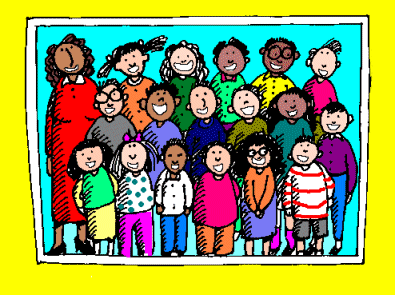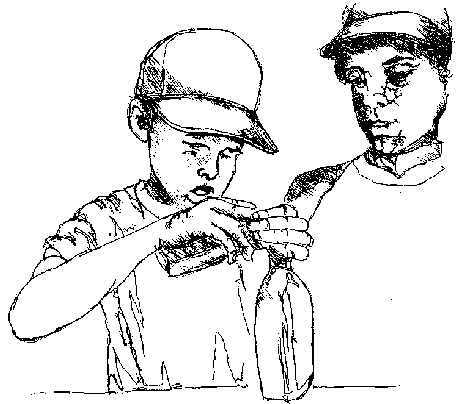Click for video about using models.
Modeling is a type of social comparison that has an important influence on children’s self-efficacy during skill acquisition. Modelingan occur in two forms:
- Children who observe a successful model similar to themselves are likely to believe that they can perform as well as the model and thereby experience higher self-efficacy (this section).
- Children can also serve as their own model by observing tapes of themselves or by mentally reviewing the steps they need to complete a project (next section).
 Digging Deeper: Research on Models
Digging Deeper: Research on Models
Considerable research has shown the usefulness of models. Teachers are important models, of course, but Dale Schunk and Antoinette Hanson (1985) found that students can be just as potent. When they showed elementary students a video of peer models learning a skill, the observers gained more in self-efficacy and achievement than when they watched a video of a teacher. Predictably, both types of models were more effective than no model at all.
Donald Meichenbaum (1971) found that models who verbalized their coping strategies were more effective than models who appeared to immediately master a task. Dale Schunk and Jo Mary Rice (1984) learned in their research that students who verbalized strategic steps had higher self-efficacy and listening comprehension performance than students who did not. They also found that verbalization prior to performing a task also had a positive impact. It is possible that verbalizing draws attention to the progress the model is making, similar to the way goal-setting allows one to monitor progress.
The variety and number of models provided also has been found to influence self-efficacy. Alan Kazdin (1974, 1975) reported that subjects who imagined multiple models rather than a single model showed greater progress. Multiple models increase the likelihood that the observer will perceive himself as similar to at least one of the models.
Remember, another important principle of modeling is perceived similarity between the observer and the model. When the observer considers herself similar to the model, learning is more likely.
How to Effectively Use Models to Increase Students’ Self-Efficacy
Student Models During Lessons
Many learning activities do not provide objective standards for assessing performance, and students must evaluate their capabilities in relation to the achievements of others. Within a classroom, students make judgments about their own abilities by assessing their progress in comparison with their classmates, as well as by observing how well classmates progress. The more a student perceives himself to be like a classmate, the more the classmate’s success or failure will have an impact on his judgment of his own ability. This perceived similarity to the model is an important factor. Models who are similar in competence provide the best yardstick for students to assess their own skills and ability.
You can easily include your students in classroom demonstrations. Select students with a variety of skill levels for the demonstration, and confirm that the student can accomplish the skill correctly in the demonstration prior to having her model it in front of the class. This modeling strategy is NOT intended for use at the end of the lesson, where students may be tempted to compare their work with what the model has accomplished. In order for the models to be effective with the student you are working with in this study, the student must perceive herself to be as skillful or more skillful than the models you are using. If your student sees someone succeed whom she believes is less skilled than herself, then she will believe that she can also perform the task. Using a model that your student believes is more skilled, will do little to improve the student’s confidence.
Oral Questioning
The common classroom practice of oral questioning provides a continual daily environment in which students assess classmates’ competencies and make comparisons. When a student correctly answers a question, a positive experience should result for the student. When a student fails to respond correctly to a teacher’s question, not only is the student’s self-appraisal of his own skill diminished, the self-efficacy of students in the classroom who perceive themselves as having abilities similar to or less than him may also decline, since they may begin to question their own ability.
The benefits of oral questioning may be limited. Although it affords teachers an easy method to assess what students have learned, it also can build inadvertent roadblocks into the learning process. Imagine that a teacher is presenting new information to her class. Suppose she asks one of the highest achieving students a question and that student is unable to answer the question. How will the incorrect answer affect other members of the class? While it may have a limited impact on those who believe they know the answer, the self-efficacy of those students who are somewhat unsure about the new material may substantially decline. They may be thinking, “This must be hard. Jane is really good at math and she could not figure it out. How will I ever be able to do it?”
Now imagine that one of the low achieving students is asked the question, and she is able to correctly answer it. Those students observing may be thinking, “This stuff is easy. Jane has trouble at math and she can do it. I will be able to easily do it.” In the latter case, the self-efficacy of the class may actually increase. The problem for teachers is that it is sometimes hard to predict how well the target student will respond. You may wish to:
- Ask open-ended questions that allow for a variety of responses.
- Develop a hand signal system with your class. You might have the students show thumbs up for a “risk-taker” answer that they are unsure about, but would like to share.
- Let students know that they do not have to proceed alone. When they are unsure or incorrect, allow them to consult with other students to develop a better answer.
- Acknowledge all who contribute to solving a question. Even students who have risked giving an incorrect answer at the start of a lesson have contributed toward the solution.
- Students can put their answers on slate boards or sheets of paper and display the boards toward the teachers. There is something less intimidating about writing an answer that can easily be erased.
 Working in Small Groups
Working in Small Groups
Students who already understand concepts can also serve as models by demonstrating the concepts to other students. Learning with and from each other takes advantage of the power of modeling. Pairing students or allowing them to work in small groups where students serve as each others’ models can be more potent than having the teacher model the lesson. Naturally, group work should be structured such that each member of a group can contribute to the process. For example, this might include having some record responses, while others look up information. High achieving students need opportunities to work with each other.
Cross-Age Tutoring
Cross-age tutoring is another effective use of modeling. Not only do the younger students look up to the older students, the older students often act much more responsible when they assume a modeling role. Cross-age grouping also gives older students an opportunity to recognize how much progress they have made, as they compare their knowledge level with younger students. It goes without saying that any one technique should be used in moderation. You may arrange for your student to tutor younger students in a lower grade.
It is important to note that students should not be expected to replace the teacher or to be private tutors. Bright students have a right to learn at a pace commensurable with their ability and it is unfair to slow their learning so they can play teacher. This is not to say that it is not possible to arrange learning opportunities in which they can serve as learning models.
Involving Former Students
Another way to use modeling is to ask some of your former students to visit your class and talk about their experiences. The value of modeling is that it lets students know that others like themselves have successfully accomplished what they are about to attempt. The more your students see themselves similar to the successful model you provide, the more confident they will be about doing well on the new task. Peers usually serve as coping models– someone who succeeds, but with some effort. Coping models are often more influential than mastery models, who appear to do well without much effort. You might arrange to have an older student from an upper grade work with the student involved in this study.
Pitfalls to avoid
Do not have high achieving students dominate recitation sessions. Despite our efforts to the contrary, students often report that teachers call upon a limited pool of students. Avoid saving the hardest questions for the highest achieving students. Not only does this practice send a message to other students about your confidence in their ability, but high achieving students often complain that they are only called upon when no one else knows the answer. Like everyone else, they don’t enjoy being stumped by questions.
Check Your Understanding:
- In order for students to set high standards and have model examples, it is effective to showcase the best students’ work.
True False
In the next section we will discuss how to use self-modeling with your student.
Next Section: Help Students Serve as their Own Model
Previous Section: Help Students Document Their Growth
© 2000 – Del Siegle – This material may not be reproduced or distributed beyond this website.